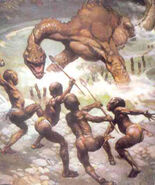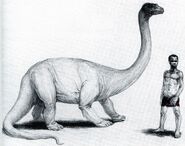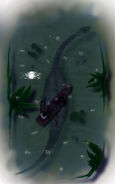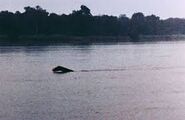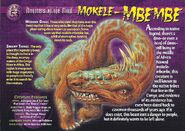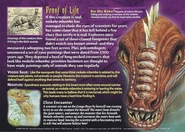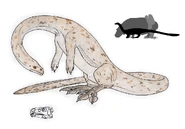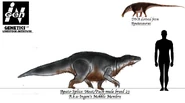The Mokèlé-mbèmbé, which means "the one who stops the flow of rivers" in the Lingala language, is a dinosaur-like cryptid that lives in the Congo. It is said to look like a sauropod, or long-neck, dinosaur, such as Apatosaurus or Diplodocus. The Mokèlé-mbèmbé was the focus of the children's book Cryptid Hunters by Roland Smith. There have been many sightings in the Congo and Cameroon. Its meat is apparently poisonous, as a group of villagers once killed one and everybody who ate the meat died shortly after. Besides the sasquatch, Loch Ness Monster and Mothman, this is one of the most well-known cryptids.
Description
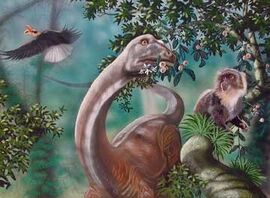
In the jungle of central Africa countries of Congo, Cameroon, and Gabon there were reports of an animal with a long neck, a long tail, and rounded shape tracks with three claws. The closest known animal that has these characteristics is a sauropod dinosaur. When some of the local people of the Likouala region would draw in the dirt or sand a representation of Mokele-mbembe they drew the shape of a sauropod dinosaur. Then when they were shown a picture of a sauropod dinosaur they said that picture is Mokele-mbembe.
Mokele-mbembe means "One that stops the flow of rivers." A French priest in the region called it "monstrous animal." Mokele-mbembe is also used as a generic term to refer to other animals like Emela-ntouka, Mbielu-mbielu-mbielu, and Nguma-monene. Mokele-mbembe has been described as an animal with a long neck and tail which are characteristics of a sauropod dinosaur.
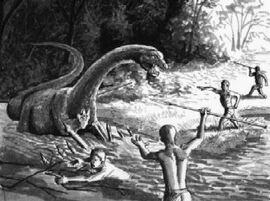
Its body size is somewhere between the size of a hippopotamus and an elephant. Its length has been reported to be between 5 to 10 meters (16 to 32 feet). The length of the neck is between 1.6 to 3.3 meters (5 to 10 feet). The length of the tail is between 1.6 to 3.3 meters (5 to 10 feet). The reports out of Cameroon have reported Mokele-mbembe to be up to 75 feet in length. There have also been reports of a frill on the back of the head. The frill is like the comb found on a male chicken. There have also been reports of it having a horn on its head. It could be based on terrified locals who have found bones of prehistoric sauropods like Paralititan, Aegyptosaurus, Vulcanodon, or Massospondylus although they only grew up to 45 feet.
The color of the skin is predominately reddish-brown with a color range from gray to brown. There are no reports of hair on the animal.
Sightings
- April 2000 - Cameroon, Boumba River, Two Congolese security guards
- 2001 - February/March - CryptoSafari, Cameroon
- 2000 - November - Gibbons-Wetzel, Cameroon
- 1992 - Operation Congo 2
- 1992 - Japanese Expedition
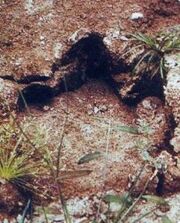
Footprint believed to be of a Mokele
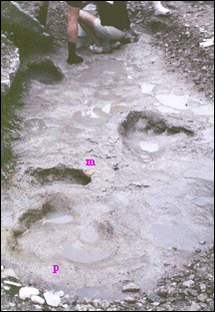
Footprints
The tracks rounded in shape between 30 to 90 centimeters (1 to 3 feet) in diameter with three claws. The distance between tracks is about 2.1 to 2.4 meters (7 to 8 feet). The basic belief is that Mokele-mbembe does not make any sounds though there have been come conflicting reports. This is probably due to the fact that Mokele-mbembe is used generically for other animals and the sound is being confused with Emela-ntouka which makes a sound like a snort, howl, roar, rumble, or growl. Mokele-mbembe lives in the pools and swamps adjacent to the rivers of the Likouala swamp region of The People's Republic of the Congo on the continent of Africa. Its uses the lakes as a crossing path to go from one river to another river.
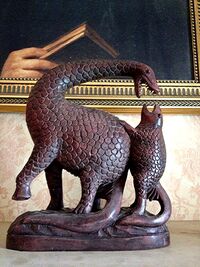
The Glencomeragh carving.
A West African carving of a strange animal, currently housed at Glencomeragh House in County Tipperary in Ireland, is believed by some cryptozoologists to represent the mokele-mbembe. It depicts a scaly animal with a long neck, a small head, cloven feet, a long tail, and a finned structure below its tale. It is alongside a smaller animal with similar features but no neck, and its relationship with the smaller animal is unclear. Although it has been suggested that the carving may be a modern creation, it has apparently been at Glencomeragh House since at least the 1950's, decades before western interest in the mokele-mbembe.
Habits

Mokele-mbembe 92 footage-0
Mokele-mbembe Sighting from BBC's 2001 Congo 2 Spirits of the Forest
The pygmies of the Likouala swamp region report that the essential diet of Mokele-mbembe consists of the Malombo plant. Since it only eats plants then Mokele-mbembe is classified as a herbivore. The Malombo plant actually describes two plants: Landolphia mannii and Landolphia owariensis. Mokele-mbembe lives most of the time underwater except when it eats or travels to another part of the swamp. It has as been reported that Mokele-mbembe does not like hippopotamuses and will kill them on sight, but it does not eat them. Hippopotamuses cannot be found where Mokele-mbembe lives. It has as been reported that Mokele-mbembe will overturn boats and kill the people from the boats by biting them and hitting them with its tail, but it does not eat the people. If this was a living sauropod most scientists and paleontologists doubt it would become hostile or carnivorous due to the fact that there are over 1,000 kinds of plants in the congo.
Hoax
- Scientists usually agree that the creature is a hoax, but others believe it could be a species of bird or other animal. The evidence for its hoax tends to be the fossil record not showing the survival of sauropods past the Kpg. A counter is that the coelacanth was found even though it was thought to be extinct since the Kpg. This can fall apart due to the fact the coelacanth was a deep water fish and fish fossils dont preserve as well as dinosaurs fossils which should preserve better. The fact coelacanth fossils have been found in Israel (although this one could be propaganda by a Muslim creationist) and Sweden after the Kpg is further evidence skeptics tend to use like Zoologist Darren naish. The other evidence such as footprints tend to show up as faulty as they can have the wrong number of toes. The fact that a new algae which was discovered in a trip to find the supposed living dinosaur and the red Clovis monkey thought to be extinct in the Congo for years can also be used as a talking point saying that if they can be discovered than why cant a 32 ft dinosaur? This has not stopped people looking for the animal.[1][2][3][4][5][6][7][8]
Explanations
Some believe the creature could be a giant lizard with a long neck, a rhino, an elephant, or even a large pangolin.
Sources
- Boxberger, Leo von "Ein Unentdecktes Grosstierart in Innerafrika," Die Umschau 42 (1938)
- Sanderson, Ivan T. "There Could Be Dinosaurs," Saturday Evening Post 220 (3 January 1948)
- Heuvelmans, Bernard (1955) On the Track of Unknown Animals, Routledge, ISBN 978-1138977525
- Heuvelmans, Bernard (1978) Les Derniers Dragons d'Afrique, Plon, ISBN 978-2259003872
- Mackal, Roy P. (1987) A Living Dinosaur? In Search of Mokele-Mbembe, Brill, ISBN 978-9004085435
- Shuker, Karl P. N. (1995) In Search of Prehistoric Survivors: Do Giant 'Extinct' Creatures Still Exist?, Blandford, ISBN 9-780713-724691
- Emmer, Rick (2010) Mokele-mbembe: Fact Or Fiction?
- Gibbons, William J. (2010) Mokele-Mbembe: Mystery Beast of the Congo Basin, Coachwhip Publications, ISBN 978-1616460105
- Shuker, Karl P. N. (2016) Still In Search Of Prehistoric Survivors - The Creatures That Time Forgot?, Coachwhip Publications, ISBN 978-1616463908
https://cryptomundo.com/cryptozoology/mokele-mbembe/
http://www.unknownexplorers.com/mokelembembe.php
http://www.science-rumors.com/10-evidences-proof-the-mokele-mbembe-still-alive/
http://www.talkorigins.org/indexcc/CB/CB930_3.html
Mokele Mbembe!." Skeptic 17.3 (2012): 63-73. Academic Search Complete. Web. 14 Nov. 2015.
https://books.google.com/books?id=NmIOAAAAQAAJ&dq=j+pinkerton+1814&source=gbs_navlinks_s
Claims of Post-Cretaceous Ichthyosaurs Part 4
https://www.academia.edu/8293900/Claims_of_Post-Cretaceous_Ichthyosaurs_Part_4
https://www.skepticblog.org/2011/06/29/a-living-dinosaur-in-the-congo-part-2/
In Popular Media
-The Mokele-Mbembe did make an appearance in the 2012 adventure movie The Dinosaur Project, even though it had a Pleiosaur appearance rather than the traditional sauropod appearance.

